Analysis of Electronic Documentation and Nurse Accountability
VerifiedAdded on 2022/08/23
|8
|1776
|16
Report
AI Summary
This report analyzes the importance of electronic documentation in nursing, emphasizing its role in promoting effective communication and accountability within healthcare teams, as highlighted by the Nursing and Midwifery Board of Australia's code of conduct. It explores the shift towards digital documentation and its impact on patient care, referencing the 'Inquest into the death of Troy Almond' to illustrate concerns related to documentation practices. The report examines guidelines for high-quality electronic documentation, including documenting facts, relevant information, and contemporaneously, while maintaining integrity. It further analyzes the case study, highlighting breaches of documentation guidelines and their consequences, particularly in the context of early warning tools and pediatric patient care. The analysis underscores the need for adherence to documentation standards, effective communication, and the utilization of tools like BTF charts to ensure patient safety and facilitate comprehensive nursing care. The report concludes by emphasizing the regulatory framework provided by the NMBA and its role in protecting the public through setting ethical standards for registered nurses.
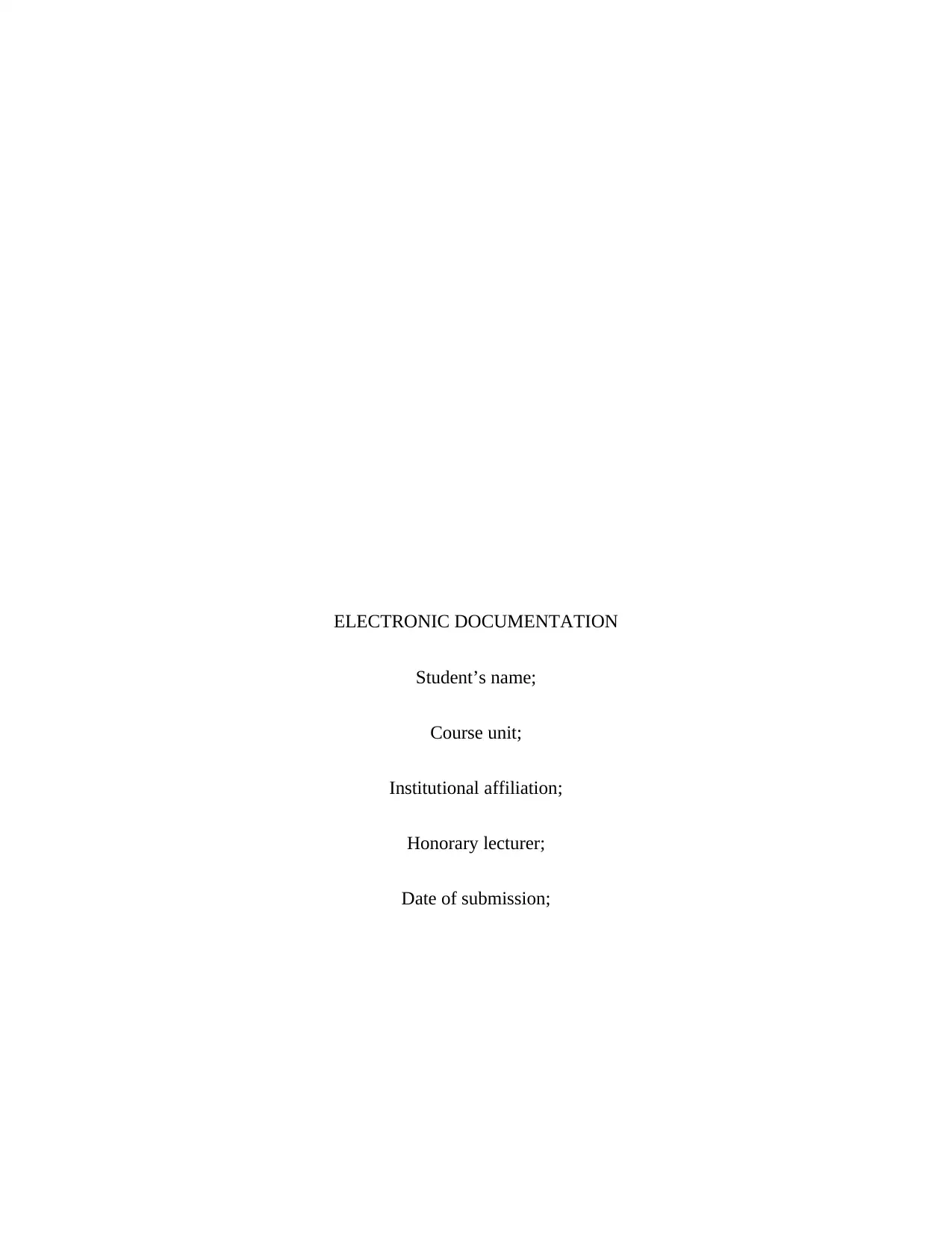
ELECTRONIC DOCUMENTATION
Student’s name;
Course unit;
Institutional affiliation;
Honorary lecturer;
Date of submission;
Student’s name;
Course unit;
Institutional affiliation;
Honorary lecturer;
Date of submission;
Paraphrase This Document
Need a fresh take? Get an instant paraphrase of this document with our AI Paraphraser
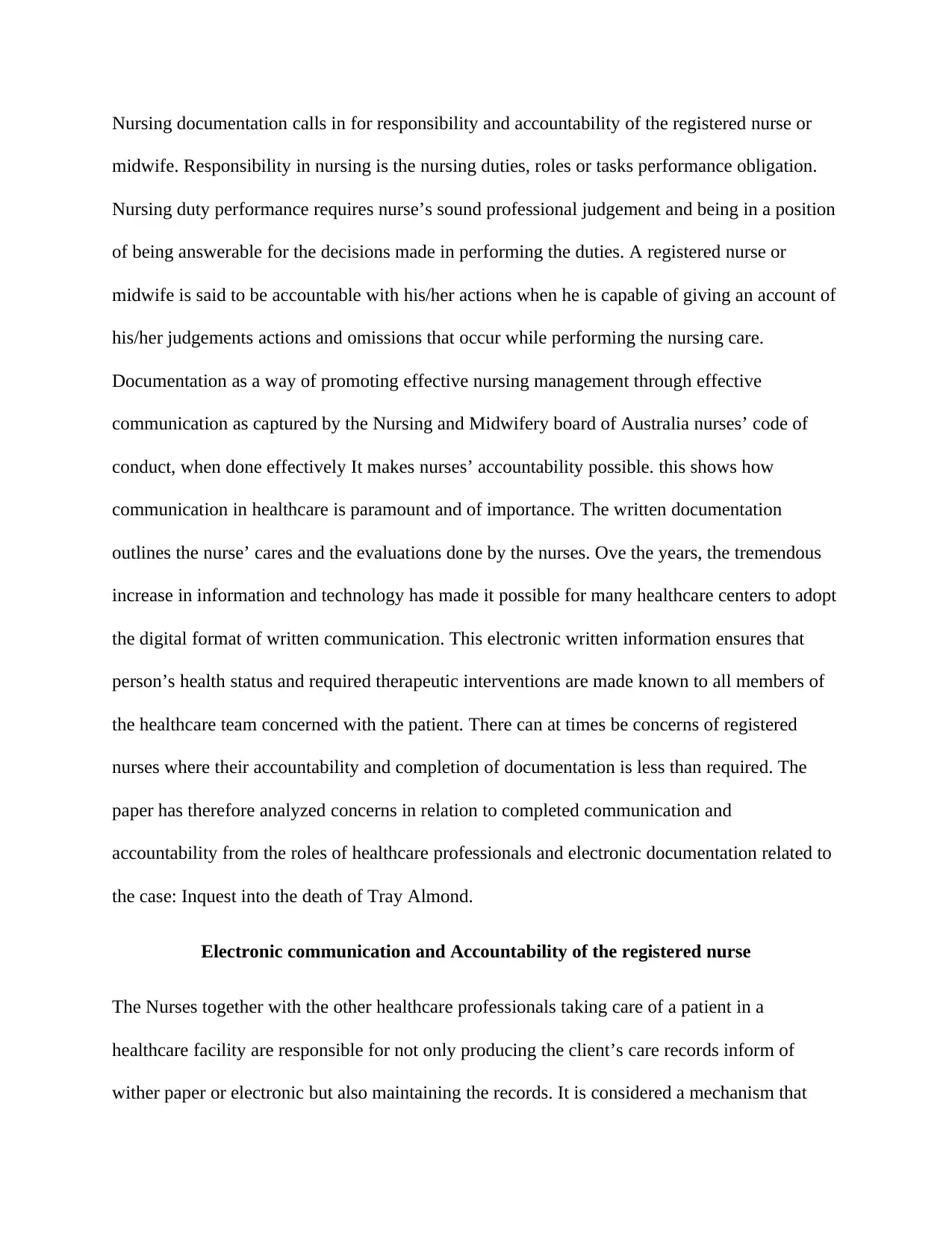
Nursing documentation calls in for responsibility and accountability of the registered nurse or
midwife. Responsibility in nursing is the nursing duties, roles or tasks performance obligation.
Nursing duty performance requires nurse’s sound professional judgement and being in a position
of being answerable for the decisions made in performing the duties. A registered nurse or
midwife is said to be accountable with his/her actions when he is capable of giving an account of
his/her judgements actions and omissions that occur while performing the nursing care.
Documentation as a way of promoting effective nursing management through effective
communication as captured by the Nursing and Midwifery board of Australia nurses’ code of
conduct, when done effectively It makes nurses’ accountability possible. this shows how
communication in healthcare is paramount and of importance. The written documentation
outlines the nurse’ cares and the evaluations done by the nurses. Ove the years, the tremendous
increase in information and technology has made it possible for many healthcare centers to adopt
the digital format of written communication. This electronic written information ensures that
person’s health status and required therapeutic interventions are made known to all members of
the healthcare team concerned with the patient. There can at times be concerns of registered
nurses where their accountability and completion of documentation is less than required. The
paper has therefore analyzed concerns in relation to completed communication and
accountability from the roles of healthcare professionals and electronic documentation related to
the case: Inquest into the death of Tray Almond.
Electronic communication and Accountability of the registered nurse
The Nurses together with the other healthcare professionals taking care of a patient in a
healthcare facility are responsible for not only producing the client’s care records inform of
wither paper or electronic but also maintaining the records. It is considered a mechanism that
midwife. Responsibility in nursing is the nursing duties, roles or tasks performance obligation.
Nursing duty performance requires nurse’s sound professional judgement and being in a position
of being answerable for the decisions made in performing the duties. A registered nurse or
midwife is said to be accountable with his/her actions when he is capable of giving an account of
his/her judgements actions and omissions that occur while performing the nursing care.
Documentation as a way of promoting effective nursing management through effective
communication as captured by the Nursing and Midwifery board of Australia nurses’ code of
conduct, when done effectively It makes nurses’ accountability possible. this shows how
communication in healthcare is paramount and of importance. The written documentation
outlines the nurse’ cares and the evaluations done by the nurses. Ove the years, the tremendous
increase in information and technology has made it possible for many healthcare centers to adopt
the digital format of written communication. This electronic written information ensures that
person’s health status and required therapeutic interventions are made known to all members of
the healthcare team concerned with the patient. There can at times be concerns of registered
nurses where their accountability and completion of documentation is less than required. The
paper has therefore analyzed concerns in relation to completed communication and
accountability from the roles of healthcare professionals and electronic documentation related to
the case: Inquest into the death of Tray Almond.
Electronic communication and Accountability of the registered nurse
The Nurses together with the other healthcare professionals taking care of a patient in a
healthcare facility are responsible for not only producing the client’s care records inform of
wither paper or electronic but also maintaining the records. It is considered a mechanism that
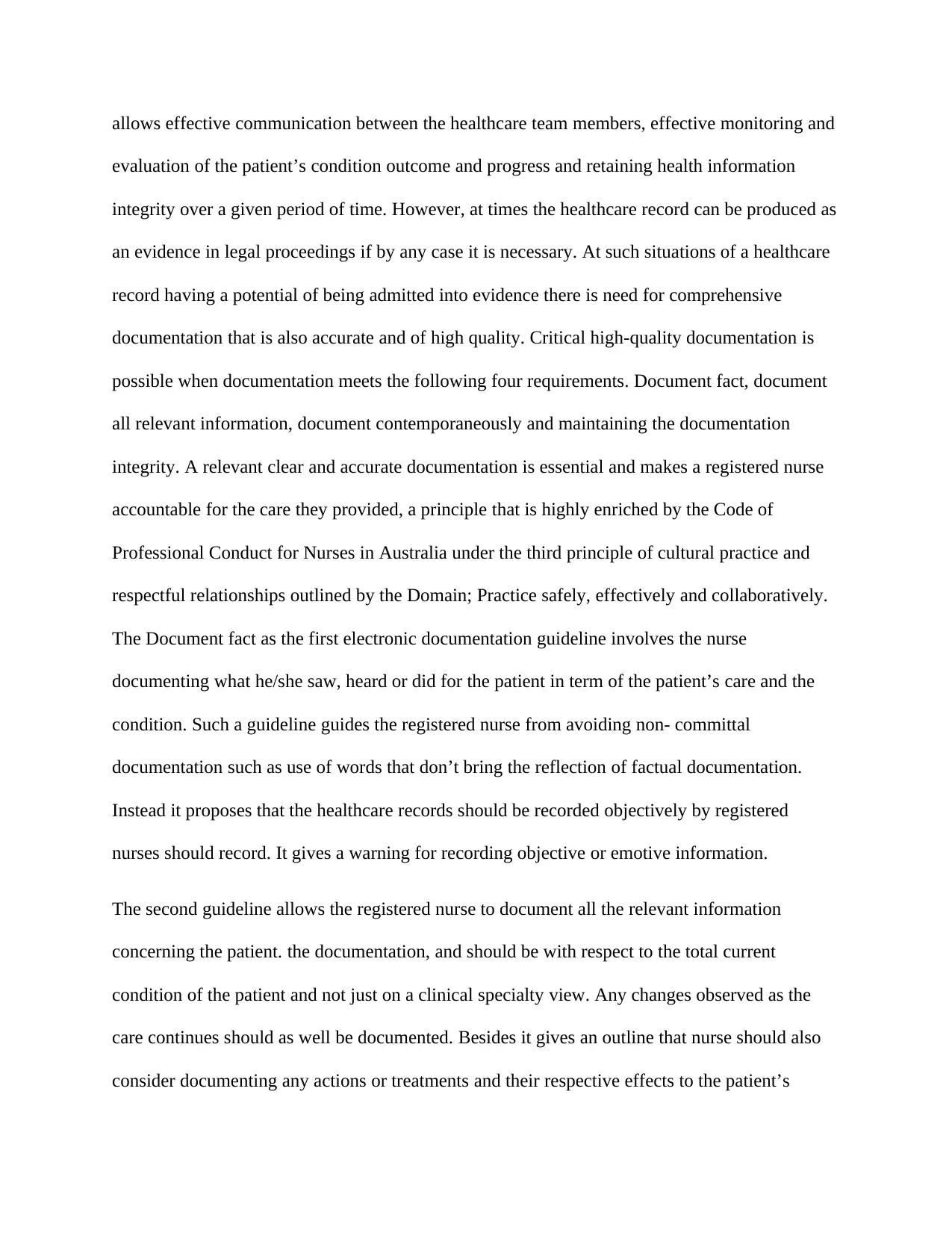
allows effective communication between the healthcare team members, effective monitoring and
evaluation of the patient’s condition outcome and progress and retaining health information
integrity over a given period of time. However, at times the healthcare record can be produced as
an evidence in legal proceedings if by any case it is necessary. At such situations of a healthcare
record having a potential of being admitted into evidence there is need for comprehensive
documentation that is also accurate and of high quality. Critical high-quality documentation is
possible when documentation meets the following four requirements. Document fact, document
all relevant information, document contemporaneously and maintaining the documentation
integrity. A relevant clear and accurate documentation is essential and makes a registered nurse
accountable for the care they provided, a principle that is highly enriched by the Code of
Professional Conduct for Nurses in Australia under the third principle of cultural practice and
respectful relationships outlined by the Domain; Practice safely, effectively and collaboratively.
The Document fact as the first electronic documentation guideline involves the nurse
documenting what he/she saw, heard or did for the patient in term of the patient’s care and the
condition. Such a guideline guides the registered nurse from avoiding non- committal
documentation such as use of words that don’t bring the reflection of factual documentation.
Instead it proposes that the healthcare records should be recorded objectively by registered
nurses should record. It gives a warning for recording objective or emotive information.
The second guideline allows the registered nurse to document all the relevant information
concerning the patient. the documentation, and should be with respect to the total current
condition of the patient and not just on a clinical specialty view. Any changes observed as the
care continues should as well be documented. Besides it gives an outline that nurse should also
consider documenting any actions or treatments and their respective effects to the patient’s
evaluation of the patient’s condition outcome and progress and retaining health information
integrity over a given period of time. However, at times the healthcare record can be produced as
an evidence in legal proceedings if by any case it is necessary. At such situations of a healthcare
record having a potential of being admitted into evidence there is need for comprehensive
documentation that is also accurate and of high quality. Critical high-quality documentation is
possible when documentation meets the following four requirements. Document fact, document
all relevant information, document contemporaneously and maintaining the documentation
integrity. A relevant clear and accurate documentation is essential and makes a registered nurse
accountable for the care they provided, a principle that is highly enriched by the Code of
Professional Conduct for Nurses in Australia under the third principle of cultural practice and
respectful relationships outlined by the Domain; Practice safely, effectively and collaboratively.
The Document fact as the first electronic documentation guideline involves the nurse
documenting what he/she saw, heard or did for the patient in term of the patient’s care and the
condition. Such a guideline guides the registered nurse from avoiding non- committal
documentation such as use of words that don’t bring the reflection of factual documentation.
Instead it proposes that the healthcare records should be recorded objectively by registered
nurses should record. It gives a warning for recording objective or emotive information.
The second guideline allows the registered nurse to document all the relevant information
concerning the patient. the documentation, and should be with respect to the total current
condition of the patient and not just on a clinical specialty view. Any changes observed as the
care continues should as well be documented. Besides it gives an outline that nurse should also
consider documenting any actions or treatments and their respective effects to the patient’s
⊘ This is a preview!⊘
Do you want full access?
Subscribe today to unlock all pages.

Trusted by 1+ million students worldwide
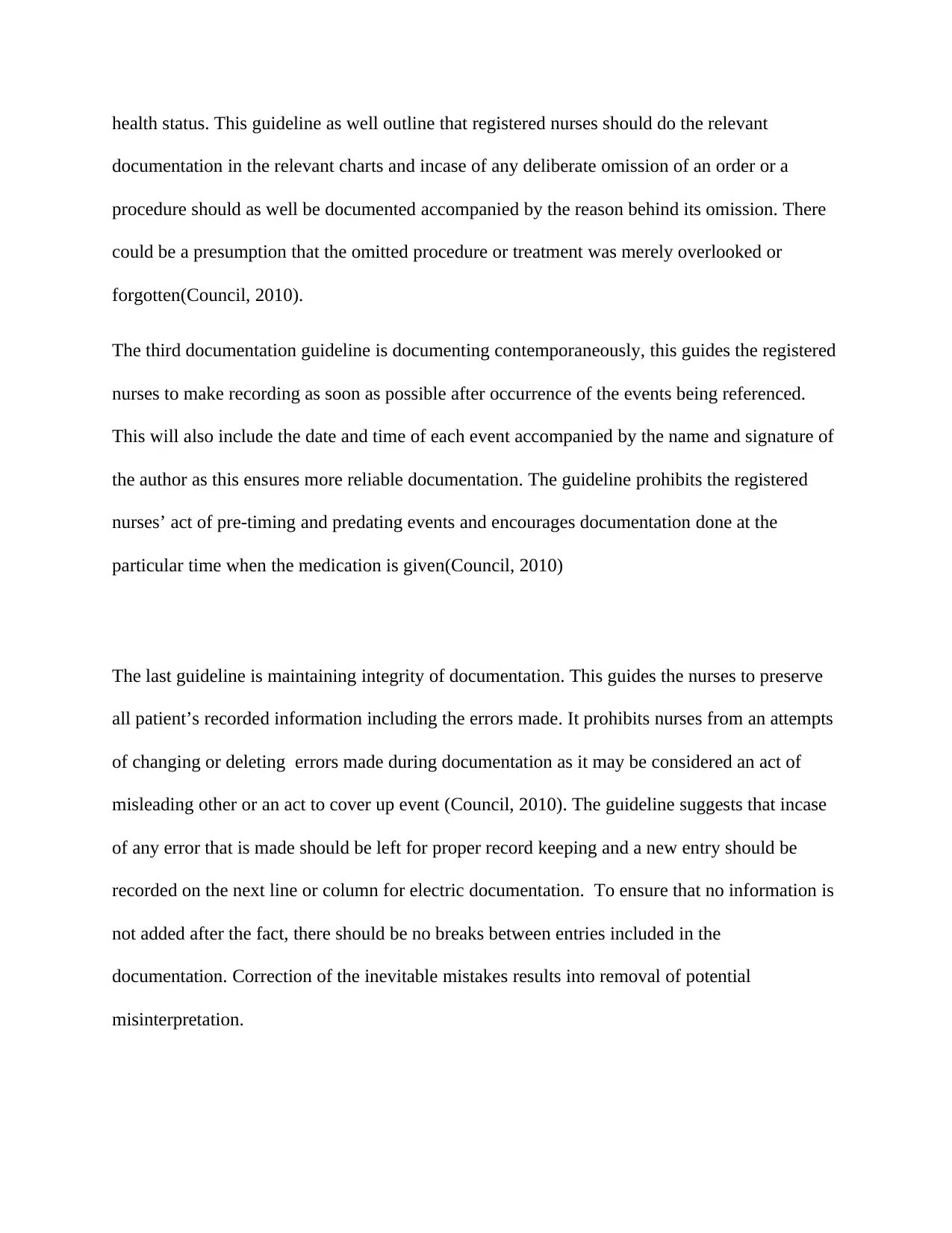
health status. This guideline as well outline that registered nurses should do the relevant
documentation in the relevant charts and incase of any deliberate omission of an order or a
procedure should as well be documented accompanied by the reason behind its omission. There
could be a presumption that the omitted procedure or treatment was merely overlooked or
forgotten(Council, 2010).
The third documentation guideline is documenting contemporaneously, this guides the registered
nurses to make recording as soon as possible after occurrence of the events being referenced.
This will also include the date and time of each event accompanied by the name and signature of
the author as this ensures more reliable documentation. The guideline prohibits the registered
nurses’ act of pre-timing and predating events and encourages documentation done at the
particular time when the medication is given(Council, 2010)
The last guideline is maintaining integrity of documentation. This guides the nurses to preserve
all patient’s recorded information including the errors made. It prohibits nurses from an attempts
of changing or deleting errors made during documentation as it may be considered an act of
misleading other or an act to cover up event (Council, 2010). The guideline suggests that incase
of any error that is made should be left for proper record keeping and a new entry should be
recorded on the next line or column for electric documentation. To ensure that no information is
not added after the fact, there should be no breaks between entries included in the
documentation. Correction of the inevitable mistakes results into removal of potential
misinterpretation.
documentation in the relevant charts and incase of any deliberate omission of an order or a
procedure should as well be documented accompanied by the reason behind its omission. There
could be a presumption that the omitted procedure or treatment was merely overlooked or
forgotten(Council, 2010).
The third documentation guideline is documenting contemporaneously, this guides the registered
nurses to make recording as soon as possible after occurrence of the events being referenced.
This will also include the date and time of each event accompanied by the name and signature of
the author as this ensures more reliable documentation. The guideline prohibits the registered
nurses’ act of pre-timing and predating events and encourages documentation done at the
particular time when the medication is given(Council, 2010)
The last guideline is maintaining integrity of documentation. This guides the nurses to preserve
all patient’s recorded information including the errors made. It prohibits nurses from an attempts
of changing or deleting errors made during documentation as it may be considered an act of
misleading other or an act to cover up event (Council, 2010). The guideline suggests that incase
of any error that is made should be left for proper record keeping and a new entry should be
recorded on the next line or column for electric documentation. To ensure that no information is
not added after the fact, there should be no breaks between entries included in the
documentation. Correction of the inevitable mistakes results into removal of potential
misinterpretation.
Paraphrase This Document
Need a fresh take? Get an instant paraphrase of this document with our AI Paraphraser
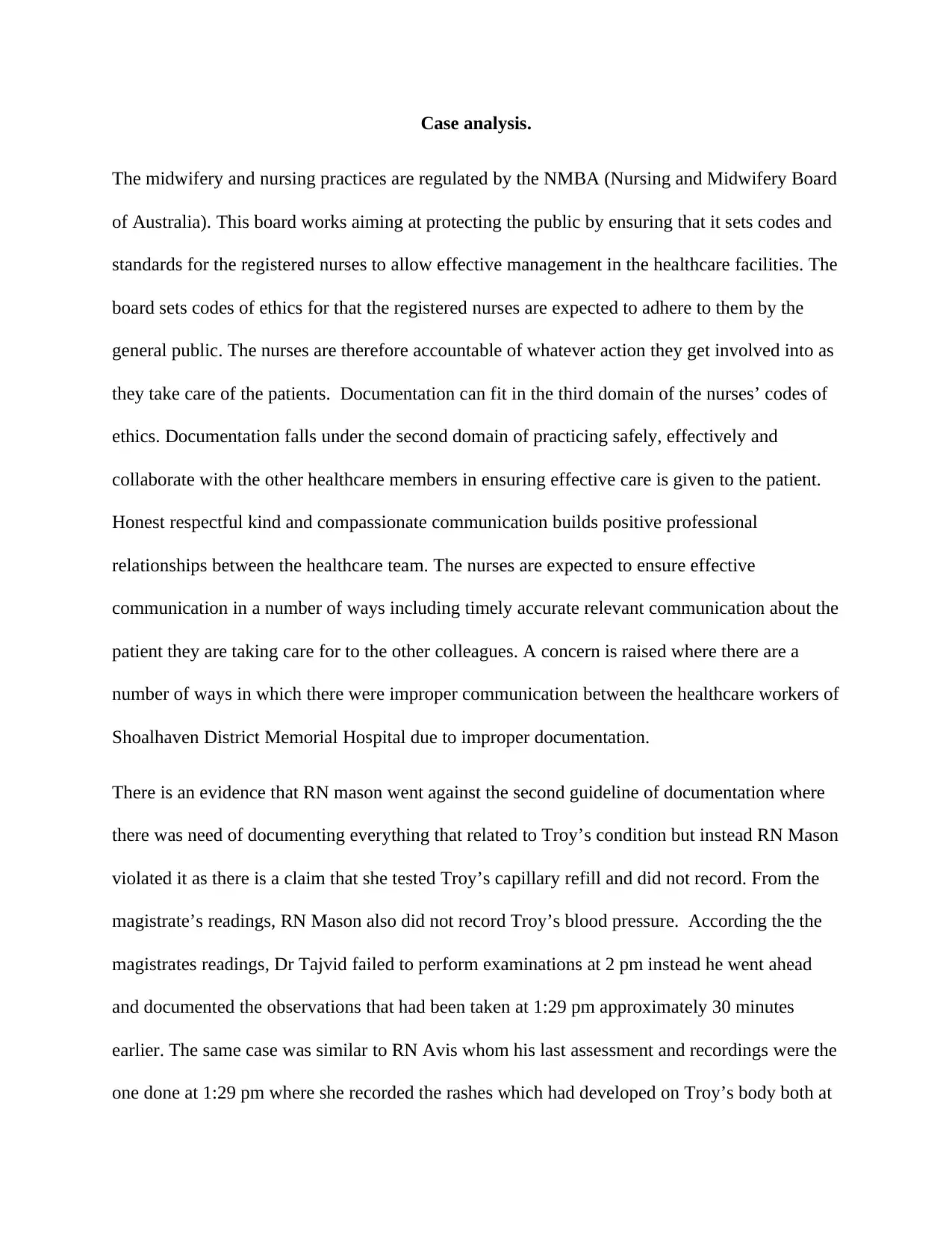
Case analysis.
The midwifery and nursing practices are regulated by the NMBA (Nursing and Midwifery Board
of Australia). This board works aiming at protecting the public by ensuring that it sets codes and
standards for the registered nurses to allow effective management in the healthcare facilities. The
board sets codes of ethics for that the registered nurses are expected to adhere to them by the
general public. The nurses are therefore accountable of whatever action they get involved into as
they take care of the patients. Documentation can fit in the third domain of the nurses’ codes of
ethics. Documentation falls under the second domain of practicing safely, effectively and
collaborate with the other healthcare members in ensuring effective care is given to the patient.
Honest respectful kind and compassionate communication builds positive professional
relationships between the healthcare team. The nurses are expected to ensure effective
communication in a number of ways including timely accurate relevant communication about the
patient they are taking care for to the other colleagues. A concern is raised where there are a
number of ways in which there were improper communication between the healthcare workers of
Shoalhaven District Memorial Hospital due to improper documentation.
There is an evidence that RN mason went against the second guideline of documentation where
there was need of documenting everything that related to Troy’s condition but instead RN Mason
violated it as there is a claim that she tested Troy’s capillary refill and did not record. From the
magistrate’s readings, RN Mason also did not record Troy’s blood pressure. According the the
magistrates readings, Dr Tajvid failed to perform examinations at 2 pm instead he went ahead
and documented the observations that had been taken at 1:29 pm approximately 30 minutes
earlier. The same case was similar to RN Avis whom his last assessment and recordings were the
one done at 1:29 pm where she recorded the rashes which had developed on Troy’s body both at
The midwifery and nursing practices are regulated by the NMBA (Nursing and Midwifery Board
of Australia). This board works aiming at protecting the public by ensuring that it sets codes and
standards for the registered nurses to allow effective management in the healthcare facilities. The
board sets codes of ethics for that the registered nurses are expected to adhere to them by the
general public. The nurses are therefore accountable of whatever action they get involved into as
they take care of the patients. Documentation can fit in the third domain of the nurses’ codes of
ethics. Documentation falls under the second domain of practicing safely, effectively and
collaborate with the other healthcare members in ensuring effective care is given to the patient.
Honest respectful kind and compassionate communication builds positive professional
relationships between the healthcare team. The nurses are expected to ensure effective
communication in a number of ways including timely accurate relevant communication about the
patient they are taking care for to the other colleagues. A concern is raised where there are a
number of ways in which there were improper communication between the healthcare workers of
Shoalhaven District Memorial Hospital due to improper documentation.
There is an evidence that RN mason went against the second guideline of documentation where
there was need of documenting everything that related to Troy’s condition but instead RN Mason
violated it as there is a claim that she tested Troy’s capillary refill and did not record. From the
magistrate’s readings, RN Mason also did not record Troy’s blood pressure. According the the
magistrates readings, Dr Tajvid failed to perform examinations at 2 pm instead he went ahead
and documented the observations that had been taken at 1:29 pm approximately 30 minutes
earlier. The same case was similar to RN Avis whom his last assessment and recordings were the
one done at 1:29 pm where she recorded the rashes which had developed on Troy’s body both at
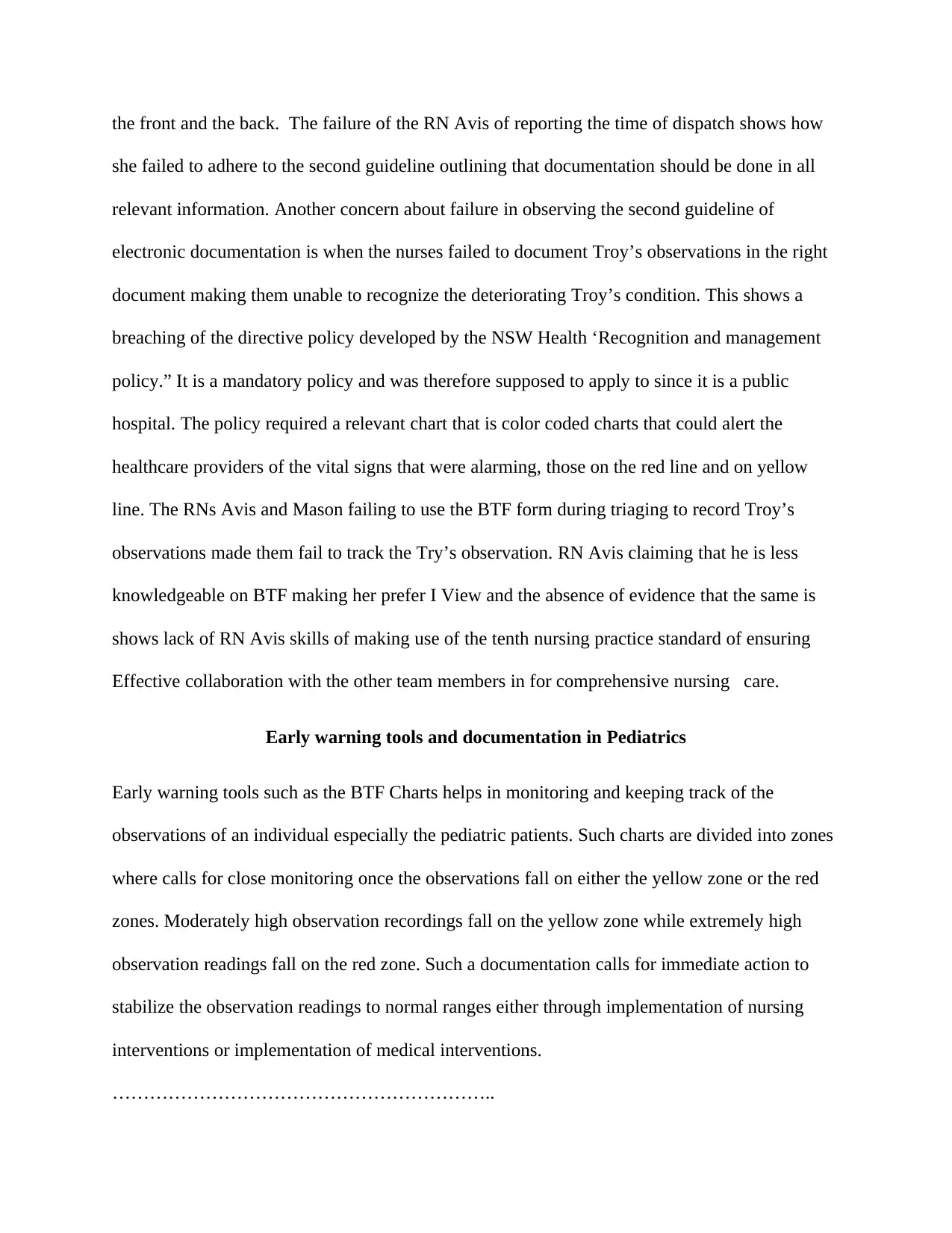
the front and the back. The failure of the RN Avis of reporting the time of dispatch shows how
she failed to adhere to the second guideline outlining that documentation should be done in all
relevant information. Another concern about failure in observing the second guideline of
electronic documentation is when the nurses failed to document Troy’s observations in the right
document making them unable to recognize the deteriorating Troy’s condition. This shows a
breaching of the directive policy developed by the NSW Health ‘Recognition and management
policy.” It is a mandatory policy and was therefore supposed to apply to since it is a public
hospital. The policy required a relevant chart that is color coded charts that could alert the
healthcare providers of the vital signs that were alarming, those on the red line and on yellow
line. The RNs Avis and Mason failing to use the BTF form during triaging to record Troy’s
observations made them fail to track the Try’s observation. RN Avis claiming that he is less
knowledgeable on BTF making her prefer I View and the absence of evidence that the same is
shows lack of RN Avis skills of making use of the tenth nursing practice standard of ensuring
Effective collaboration with the other team members in for comprehensive nursing care.
Early warning tools and documentation in Pediatrics
Early warning tools such as the BTF Charts helps in monitoring and keeping track of the
observations of an individual especially the pediatric patients. Such charts are divided into zones
where calls for close monitoring once the observations fall on either the yellow zone or the red
zones. Moderately high observation recordings fall on the yellow zone while extremely high
observation readings fall on the red zone. Such a documentation calls for immediate action to
stabilize the observation readings to normal ranges either through implementation of nursing
interventions or implementation of medical interventions.
……………………………………………………..
she failed to adhere to the second guideline outlining that documentation should be done in all
relevant information. Another concern about failure in observing the second guideline of
electronic documentation is when the nurses failed to document Troy’s observations in the right
document making them unable to recognize the deteriorating Troy’s condition. This shows a
breaching of the directive policy developed by the NSW Health ‘Recognition and management
policy.” It is a mandatory policy and was therefore supposed to apply to since it is a public
hospital. The policy required a relevant chart that is color coded charts that could alert the
healthcare providers of the vital signs that were alarming, those on the red line and on yellow
line. The RNs Avis and Mason failing to use the BTF form during triaging to record Troy’s
observations made them fail to track the Try’s observation. RN Avis claiming that he is less
knowledgeable on BTF making her prefer I View and the absence of evidence that the same is
shows lack of RN Avis skills of making use of the tenth nursing practice standard of ensuring
Effective collaboration with the other team members in for comprehensive nursing care.
Early warning tools and documentation in Pediatrics
Early warning tools such as the BTF Charts helps in monitoring and keeping track of the
observations of an individual especially the pediatric patients. Such charts are divided into zones
where calls for close monitoring once the observations fall on either the yellow zone or the red
zones. Moderately high observation recordings fall on the yellow zone while extremely high
observation readings fall on the red zone. Such a documentation calls for immediate action to
stabilize the observation readings to normal ranges either through implementation of nursing
interventions or implementation of medical interventions.
……………………………………………………..
⊘ This is a preview!⊘
Do you want full access?
Subscribe today to unlock all pages.

Trusted by 1+ million students worldwide

Paraphrase This Document
Need a fresh take? Get an instant paraphrase of this document with our AI Paraphraser
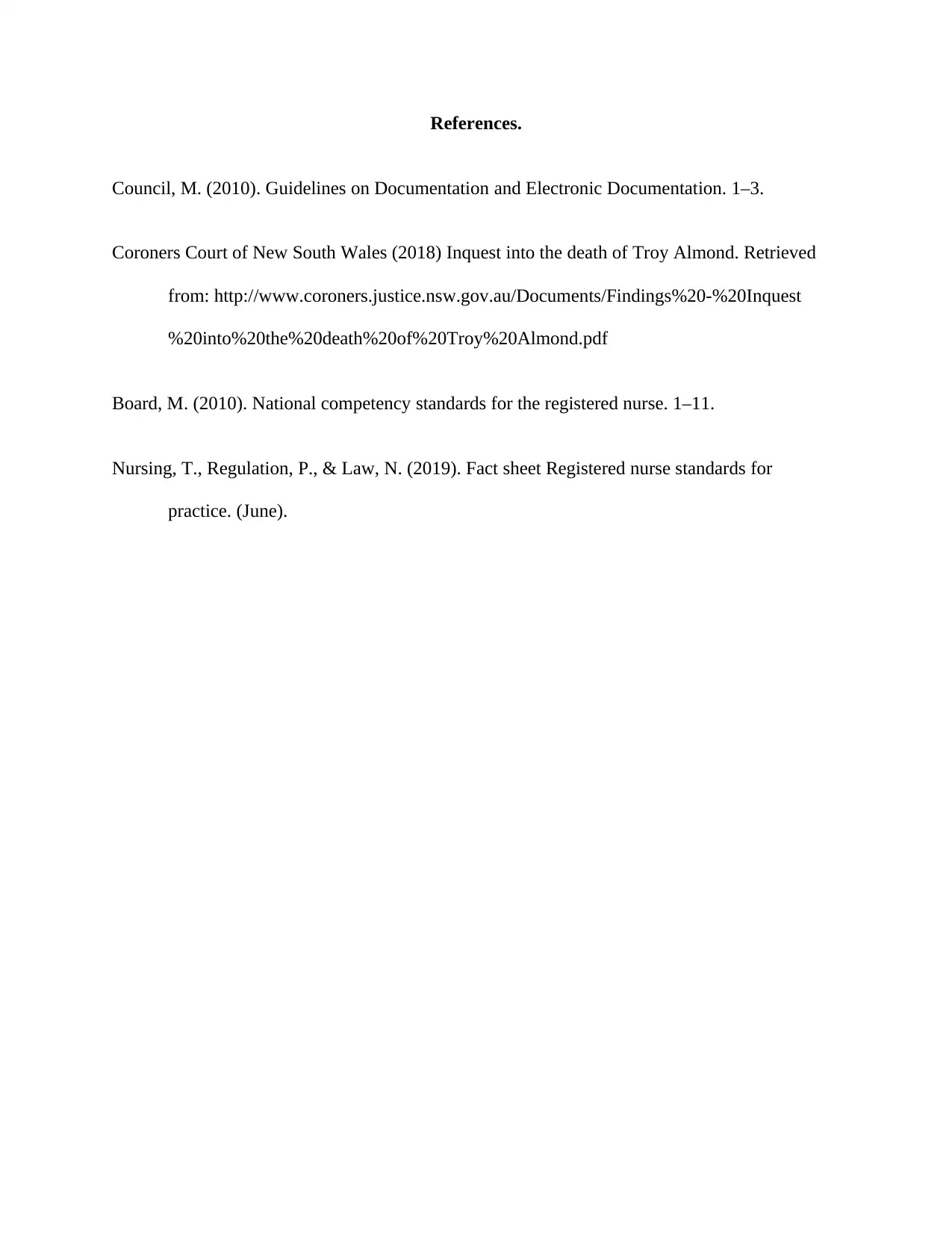
References.
Council, M. (2010). Guidelines on Documentation and Electronic Documentation. 1–3.
Coroners Court of New South Wales (2018) Inquest into the death of Troy Almond. Retrieved
from: http://www.coroners.justice.nsw.gov.au/Documents/Findings%20-%20Inquest
%20into%20the%20death%20of%20Troy%20Almond.pdf
Board, M. (2010). National competency standards for the registered nurse. 1–11.
Nursing, T., Regulation, P., & Law, N. (2019). Fact sheet Registered nurse standards for
practice. (June).
Council, M. (2010). Guidelines on Documentation and Electronic Documentation. 1–3.
Coroners Court of New South Wales (2018) Inquest into the death of Troy Almond. Retrieved
from: http://www.coroners.justice.nsw.gov.au/Documents/Findings%20-%20Inquest
%20into%20the%20death%20of%20Troy%20Almond.pdf
Board, M. (2010). National competency standards for the registered nurse. 1–11.
Nursing, T., Regulation, P., & Law, N. (2019). Fact sheet Registered nurse standards for
practice. (June).
1 out of 8
Related Documents
Your All-in-One AI-Powered Toolkit for Academic Success.
+13062052269
info@desklib.com
Available 24*7 on WhatsApp / Email
![[object Object]](/_next/static/media/star-bottom.7253800d.svg)
Unlock your academic potential
Copyright © 2020–2025 A2Z Services. All Rights Reserved. Developed and managed by ZUCOL.





